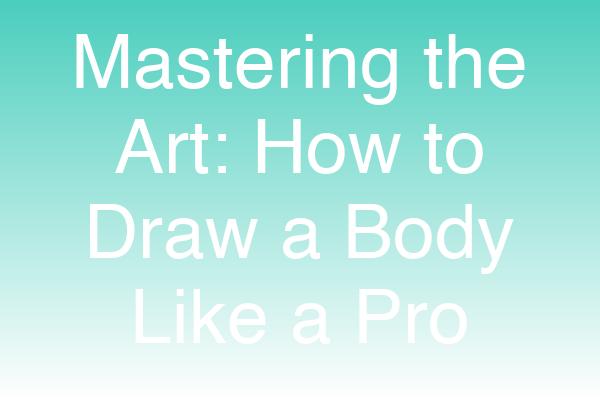
Categories: Art Techniques, Drawing Tutorials, Creative Skills
Tags: how to draw a body, figure drawing, anatomy for artists, drawing tips, art tutorials, sketching techniques, drawing basics
How to Draw a Body: A Comprehensive Guide for Aspiring Artists
Drawing the human body can be one of the most challenging yet rewarding experiences for artists. Whether you're a beginner or looking to refine your skills, understanding the fundamentals of anatomy and proportions is crucial. In this guide, we will explore how to draw a body step-by-step, providing you with expert insights, tips, and techniques to elevate your artistic abilities.
Introduction
Have you ever wondered how professional artists create lifelike figures? The secret lies in mastering the basics of anatomy and proportions. In this article, we will delve into how to draw a body effectively, covering everything from basic shapes to advanced techniques. By the end of this guide, you'll have the tools you need to create dynamic and realistic figures in your artwork.
Understanding Body Proportions
Before you start drawing, it's essential to grasp the concept of body proportions. The human body can be broken down into manageable parts, which makes it easier to sketch. Here’s a quick overview of the basic proportions:
| Body Part | Proportion (in heads) |
|---|---|
| Head | 1 head |
| Neck | 1/4 head |
| Torso | 2 heads |
| Arms | 1.5 heads each |
| Legs | 2 heads each |
| Total Height | 7.5 to 8 heads |
Key Proportions to Remember:
- Average Height: The average adult human figure is about 7.5 to 8 heads tall.
- Shoulder Width: Typically, the shoulder width is about 2 to 3 heads wide.
- Hip Width: The hips are generally about the same width as the shoulders.
Step-by-Step Guide on How to Draw a Body
Step 1: Start with Basic Shapes
Begin by sketching the basic shapes that represent the head, torso, and limbs. Use simple geometric forms like ovals and rectangles to outline the figure.
- Head: Draw a circle for the head.
- Torso: Use an oval for the torso.
- Limbs: Draw lines for arms and legs, and add circles for joints.
Step 2: Establish the Pose
Decide on the pose you want to draw. Use dynamic lines to indicate movement and direction. A relaxed pose will have softer lines, while an action pose will have more angular lines.
Step 3: Refine the Shapes
Once you have the basic outline, start refining the shapes. Add curves to the torso and limbs to create a more natural look.
Step 4: Add Details
Now it’s time to add details such as facial features, muscles, and clothing. Pay attention to the anatomy and how muscles interact with the skin.
Step 5: Shading and Texturing
To give your drawing depth, add shading. Observe how light interacts with the body and use hatching or cross-hatching techniques to create shadows.
Expert Tips for Drawing the Human Body
- Practice Gesture Drawing: Spend a few minutes each day sketching quick poses to improve your understanding of movement and proportion.
- Study Anatomy: Familiarize yourself with human anatomy through books or online courses. Understanding muscle groups and bone structure will enhance your figure drawing.
- Use References: Don’t hesitate to use reference images or live models. Websites like Unsplash or Pexels offer free images to practice with.
- Experiment with Styles: Try different styles, from realistic to cartoonish, to find your unique artistic voice.
Common Mistakes to Avoid
- Ignoring Proportions: Always keep proportions in mind; they are crucial for a realistic figure.
- Overcomplicating Details: Focus on the overall form before diving into intricate details.
- Neglecting Practice: Consistent practice is key to improvement. Set aside time daily or weekly for figure drawing.
Conclusion
Learning how to draw a body is a journey that requires patience and practice. By mastering the basics of proportions, shapes, and anatomy, you can create stunning figures that convey emotion and movement. Remember to keep practicing and experimenting with different techniques.
Call-to-Action: Ready to take your drawing skills to the next level? Download our free anatomy reference guide and start practicing today!
Social Media Snippet: 🎨 Want to learn how to draw a body like a pro? Check out our comprehensive guide filled with expert tips and step-by-step instructions! #Art #DrawingTips
Suggested Internal Links:
- Essential Drawing Techniques for Beginners
- Understanding Human Anatomy for Artists
- Top 10 Drawing Tools Every Artist Needs
Suggested External Links:
FAQs
Q1: What materials do I need to start drawing the human body?
A1: Basic materials include pencils, erasers, sketch paper, and optionally, colored pencils or markers for shading.
Q2: How can I improve my figure drawing skills?
A2: Regular practice, studying anatomy, and using references will significantly enhance your skills.
Q3: Is it necessary to understand anatomy to draw the human body?
A3: While it's not strictly necessary, understanding anatomy will greatly improve the accuracy and realism of your drawings.
Q4: Can I draw the human body from imagination?
A4: Yes, with practice and a strong understanding of proportions and anatomy, you can draw from imagination.
Q5: What is gesture drawing, and why is it important?
A5: Gesture drawing involves capturing the essence of a pose quickly. It helps improve your understanding of movement and flow in figure drawing.
By following this comprehensive guide on how to draw a body, you’ll be well on your way to creating impressive and lifelike figures in your artwork. Happy drawing!